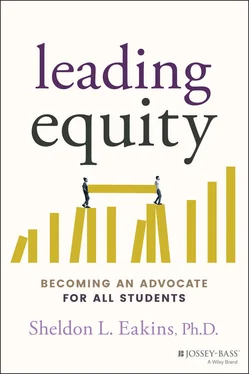Although we may not realize it, implicit bias impacts the decisions we make as educators. Here's an overview of five common forms of implicit bias. For each type of bias, there are two concrete examples of how this bias might manifest in an educational setting. For each example, there is a corresponding scenario that shows how one might mitigate implicit bias in the situation.
| Type of Bias |
What Does this Bias Look Like in Action? |
How Might One Mitigate This Type of Bias? |
| Affinity BiasAffinity bias is when a person gravitates toward individuals with whom they have an affinity, such as a common interest or experience. |
An administrator reviews candidates' application materials during the hiring process and gravitates toward applicants who are like them or who are like teachers with whom they have worked. |
The administrator selects a diverse hiring committee and intentionally brings in candidates with a range of backgrounds, ideas, and perspectives. They recognize that overcoming biases requires us to place value in diversity. |
| A particular student reminds a teacher of their own biological child, and the teacher unconsciously gives that student preferential treatment. |
The teacher makes a concentrated effort to increase social interaction with students who are different from them. As the teacher develops these connections, they discover commonalities! |
| Confirmation BiasConfirmation bias is the tendency for an individual to interpret new evidence as confirmation of their previously existing beliefs or theories. |
A teacher notices multiple disciplinary referrals in a new student's file. When the student displays hyperactivity during class, the teacher writes them up for insubordination and noncompliance. |
Before taking disciplinary actions, the teacher reflects on the underlying factors that may be influencing this student's behavior. The teacher audits their classroom resources and practices to ensure that the learning environment promotes the student's success. |
| Asian American students in a particular school division have traditionally outperformed their peers in math. It becomes school practice that if an Asian American student has a high overall GPA, the school counselor encourages the student to enroll in AP Calculus. |
School counselors, teachers, and leaders get to know their students as individuals to advocate for them. After identifying students' interests, educators provide them with experiences and opportunities that both reflect those interests and expose them to new ideas and perspectives. |
| Conformity BiasConformity bias is a bias that is formed through peer pressure. |
A first-year teacher tries to support a new student who speaks Spanish as their first language by using visuals and nonverbal cues to make the content more accessible. After learning that other teachers at the school do not offer these supports to English language learners, the first-year teacher decides not to offer them to the student either. |
The first-year teacher seeks to develop a group of critical friends, who may or may not be the colleagues who work in the same building or with the same students. The teacher establishes classroom procedures that allow students to provide feedback about their experiences as learners. |
|
| Most high school administrators in a school division have decided to speak out in support of a zero-tolerance policy. The principal of the most culturally diverse high school is interested in restorative justice but decides to support the zero-tolerance policy since it is what the other school leaders believe is best. |
The administrator sets aside time in their weekly routine to reflect on their values and their alignment with their actions. The administrator captures those values succinctly in a vision statement, mission statement, or mantra that they share publicly. The leader is comfortable with being uncomfortable! |
| Halo Effect BiasThe halo effect bias is when a person notes one positive or exceptional aspect about an individual and allows the “halo” glow of that characteristic to sway their opinions of everything else about that individual. |
African American female students who have lighter skin and longer hair are called on more frequently in class and are more frequently recommended for student leadership roles. |
The teacher tracks classroom data regarding their interactions with students, such as questioning, discipline, and rewards. When possible, the teacher enlists the help of a colleague or instructional coach to help record this data. |
| A white student consistently performs in the top tier on their academic assessments, and the teacher frequently ignores their misbehavior and the way they mistreat other students. |
The teacher implements regular community circles to check in with students and build a classroom community of learners based on trust and mutual respect. The teacher uses restorative practices to support students in repairing harm to each other and the community. |
| Horn Effect BiasThe horn effect is the opposite of the halo effect bias. The horn effect bias is when a person notes one negative aspect of an individual and allows that aspect to influence their perceptions of the individual's overall attributes. |
A Hispanic student performs poorly on their initial assessment, and for the rest of the year, the teacher scores the student's work lower than that of their equal ability peers. |
The teacher incorporates a range of assessment techniques throughout the year, which allow students' unique gifts to shine. When grading traditional assessments, the teacher practices blind grading to avoid implicit bias. |
| An African American male student made a poor behavioral choice in the previous academic year, which resulted in a suspension. This year, teachers overlook his leadership capabilities and creativity, which causes him to miss out on scholarship opportunities. |
Teachers at the school research and acknowledge the statistics regarding the school-to-prison pipeline. They promote programs and activities that support the social and academic success of historically marginalized students. |
Before we wrap up this chapter, I want to share with you a journal exercise that you can do to understand where your biases may originate. Follow this series of daily journal prompts to reflect honestly and individually about your personal experiences and the way they have shaped your implicit biases. At the end of the week, use your reflections to consider how your formative experiences have impacted your relationship with and development of implicit bias.
Think about the various social groups to which you belong. What do you view as your defining characteristics? What might others view as your defining characteristics?
Identify the five people you would consider to be the closest to you during your lifetime.
What characteristics do these individuals have in common? Consider race, gender, age, ability, sexuality, appearance, and behaviors.
Based on these commonalities, what can you infer about your own preferences and values?
Reflect on your interactions as a young person. What level of diversity did you encounter in your everyday experiences?












